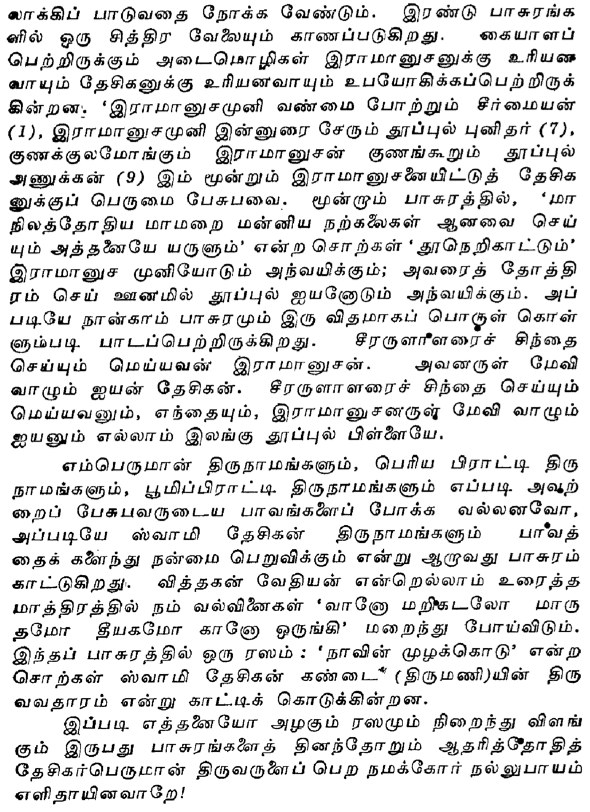We cannot survive as Sri VaishNavAs unless we sing the glory of the compassion and genius of Swami Desikan. The SiddhAntham (Bhagavadh RaamAnuja SiddhAntham) strengthened by him is the only one upAyam for our survival as spiritual aspirants. Lord of the Seven Hills did indeed take birth as Swami Desikan. When we reflect upon the glory of Swami Desikan and the granthAs with which he has blessed us and the way he showed us to Moksham (Prapatthi maargam), all of our sins will fly far away. All auspiciousness will come about, when we take refuge at his sacred feet. There are no other means for our survival or spiritual advancement without his grace. Sri NayanarAchAryar goes on to pray to his AchAryA for the fruits of Moola Manthram and guile-free bhakthi and begs for the retention of the subhAsrayam (ThirumEni) of Swami Desikan in his mind always.
Sri NayanarAchAryar then sings pallANdu to his AchAryA and concludes the prabhandham with the statement that those, who recite PiLLaiandhAthi with devotion, would have the distinction of having Swami Desikan’s sacred feet on their heads as alankAram (SirO bhooshaNam) and protection (RakshaNam).
The author of this moving tribute of a sishya to his AchAryan is KumAra VaradAchAryaar. He was the illustrious son of Swami Desika. He was born in 1317 AD (Pingala Year). Swamy Desikan was 49 years old at that time and had settled down in Srirangam. Let us refresh our minds on the life and Vaibhavam of Swamy Desikan’s illustrious son with the help of a write up from Sriman Anbil Ramaswamy.
Swami Desika was succeeded by his son and disciple, Kumara Varadacharya also known as Nayanaracharya. A scholar, like his illustrious father, Nayanar Acharya was an able exponent of Sri Visihtadvaita Vedanta. In a philosophical debate, he defeated the Sakalya Malla, the author of Udhara Raghava and an expert in black magic. Nayanar Acharya toured extensively in Kerala country and converted many into Vaishnavism. In Andhra, one Sarvagna Singappa of Nayak family of Rajahmundry patronized him and became his well-known disciple.
Nayanar Acharya’s chief objective in life was to celebrate his AchAryan and propagate his doctrines and writings. At the Srirangam temple, he set up an idol of his famous father. He vanquished many Advaitins in debates held in Tirukkoshtiyur, Tiru maal irum cholai, and Madurai. During his stay at Vennar bank, Thanjavur, he installed an image of his father in the temple of Neelamegha Perumal. (Later, he installed the images of Desika for worship at Kanchi, Tiruvaheendrapuram, Maduraantakam, Thooppul, Sriperumpudur and other Divya Desas). Nayanar Acharya is said to have authorized the recitation of the Tanians of Naalaayira Prabhandam and Desika Prabhandam during the Anadhyayana period when the recitation of Dhivya Prabhandam remains suspended.
He classified the 120+ works of his father under 6 heads. He composed Pillai Anthaadhi- a poetic tribute to his father in 20 stanzas. He has 8 works to his credit, namely Tattva Surkkam, Rahasya Surukkam, Adhikarana Chintaamani, Rahasya Traya Saaraartha Sangraha, Pillai Anthaadhi, Abheda Khandanam, Avidyaa Khandanam and Prapancha Mityathva. He composed the famous Tanian “Srimaan Venkata Naathaarya” which is always recited today before the Sanskrit hymns of Swami Desika.
Isvara Samvathsaram Simha SrAvaNa Month, KrishNa Paksham, Dasami thithi, Mrugaseersham.
On this auspicious combination of Mrugaseersham and KrishNa paksha Dasami day after Sri Jayanthi celebration, a son was born to Swami Desikan at Thuppul. This was some 700 years ago. Like the lamp lit from a lamp, this blessed child learnt all saasthrAs (SakalArtha GrahaNam) and became the principal sishyA of Swami Desikan. The great ParamAchAryA gave the name of his aarAdhana murhty, Sri Kanchi VaradarAjan to his only child. There is a tradition in Kanchipuram to call small children Nayana, Nayana. YasOdhA probably would have called her dear son, “Nayana”, if He were to be born in Kanchi. Our ParamAchAryA, who blessed us with GopAla Vimsathi had a great affection for Sri KrishNA and hence it is no wonder, the child came to be called Nayana and then, when the child grew up and took on the mantle of the father as an AcharyA in his own right, he was called Sri NayanArAchAryar in spite of his given name of Sri Kumaara VardAchAryar. The Lord of Kanchi blessed the child of His dear devotee with all SoubhAgyams and visEsha J~nAnam. The son’s reverence for his father and AchArya poured out in the KattaLaikalitthurai metre verses known as “PiLLaiandhAthi”. There are 20 beautiful devotional verses in this AndhAthi composed by the dear son and the pradhna sishyan of Swami Desikan. Most of them are modeled after the verses in RaamAnuja NoorandhAthi. Swami Desikan’s reverence for Achaarya RamAnujA poured forth in the 70 verses of YathirAja sapthathi. Sri NayanArAchAryAr’s devotional surrender to his AchAryA flowed in the 20 verses of PiLLaiandhAthi. The adjectives and the allusions here are recognizable echoes of Thiruvarangatthu AmudanAr’s verses celebrating Achaarya RaamAnujA’s glory.
TANIYAN SALUTING THE AUTHOR OF PILLAIANDHATHI
sIrArthUppul piLLaiyandhAdi yenRu sezhuththamizhAl
nErAga Vedanta dEsikar thALiNaikkIzh mozhindAn
erAr maRaipporuLelAmeduth thivvulakuyyavE
sIrAgiya varathArriyan pAtham thuNai namakkE
MEANING:
The pair of sacred feet of Sri NayanarAchAryAr are the refuge for us. He is indeed the embodiment of all auspicious attributes. He blessed the world with his PiLLai AndhAthi, a work in impeccably pure Tamizh (Sezhum Tamizh), which is the essence of the distillation of the truths of vEdhAs resulting from his deep study of the scriptures under the holy feet of his acharyA and parent, Sri Vedaantha Desikan. I seek as refuge the redeeming feet of Sri VaradAchAryAr, who was affectionately called as NayanarAchAryar.
Courtesy: Sri V. Madhavakannan & Oppiliappan Koil Sri Varadachari Sathakopan
to be continued…















